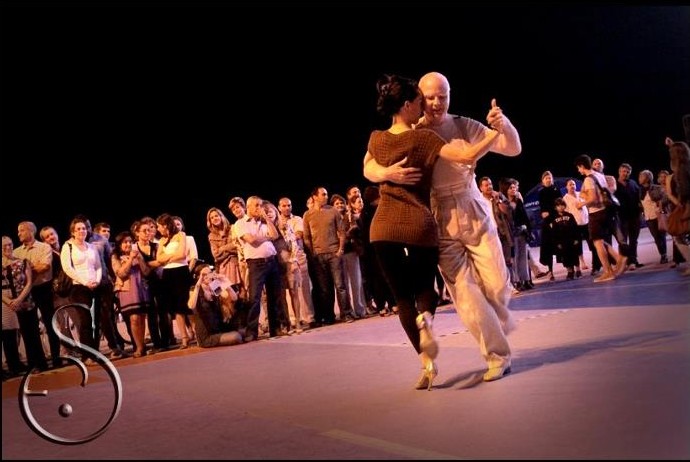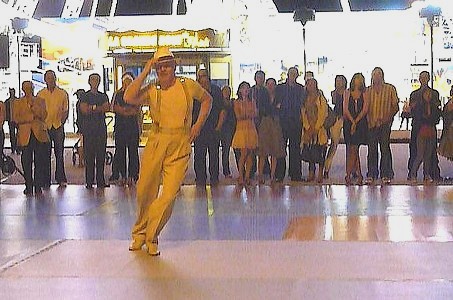
General approach of the dance
Dominique Lescarret likes to say that "Tango is a simple yet complex dance ". The formula seems paradoxical, but it develops in the following way: Argentine Tango requires few physically complex things, but it is based on the simultaneity of execution of many simple but essential gestures creates the complexity. According to this point of view, a methodical approach of this dance makes it much easier to learn. While Dominique was learning, Gustavo Naveira once said to him: “It is necessary to understand the system first”. This sentence struck him as something fundamental; then all becomes simple..
After analyzing them, we can notice that the most complex figures of tango are only using extremely simple elements that have been seen previously. However, most of these figures are approached as novelties... If we replace them in an already known and mastered system, they appear to be much more accessible. It is the teacher’s role to guide his pupil towards an easy and accessible way of apprenticeship.
Educational construction
Dominique Lescarret, and his Professional Institute of Tango, are both members of International Council of the Dance, of Unesco.
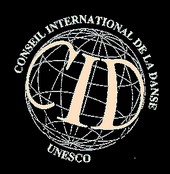 So that an educational construction can be successfully set up, it is necessary to establish at first the major bases which it has to lean on. Dominique Lescarret likes to say as a joke, that the first dancer of Argentine tango whose principles it is necessary to respect was called Isaac Newton. The basic mechanics, associated with the specificities of the human body, give what we call biomechanics; thoroughly respecting these principles is fundamental for easy and pleasant apprenticeship and practice.
So that an educational construction can be successfully set up, it is necessary to establish at first the major bases which it has to lean on. Dominique Lescarret likes to say as a joke, that the first dancer of Argentine tango whose principles it is necessary to respect was called Isaac Newton. The basic mechanics, associated with the specificities of the human body, give what we call biomechanics; thoroughly respecting these principles is fundamental for easy and pleasant apprenticeship and practice.
From the individual to the couple, the notions of connection, leading and work for two will have to come far before the learning of any figure. At the same time, respect for the rhythm which allows synchronization, and placement of the bodies in a good position at a given point, will be a priority versus physical performance and apparent virtuosity.
Finally, totally released from technique, the notion of improvisation will come, but the distinctive feature of this approach is that work is essential and prior to expression
« The importance of mastering a technique, it is that it allows to express a feeling » Picasso
« Art is an additional emotion which comes on top of a skillful technique » Charlie Chaplin
« Trabajar, trabajar, sacarle viruta al piso hasta romper los zapatos »
" Work, work, extract the splinters of the floor until you wreck your shoes"
Anonymous, quoting a formula which appeared in Canaro’s “Milonga Arrabalera
In short, absolute respect for biomechanics, analysis of the system, establishment of the connection, setting up of simple exercises before any learning of figures, respect of rhythm and music… plus a specific work on Abrazo...
...and a few little secrets...
Pyramid of tango
In introduction of his vocational training, Dominique Lescarret proposes to his students, the following pyramid which clarifies the order of the priorities and the specificities of the tango.
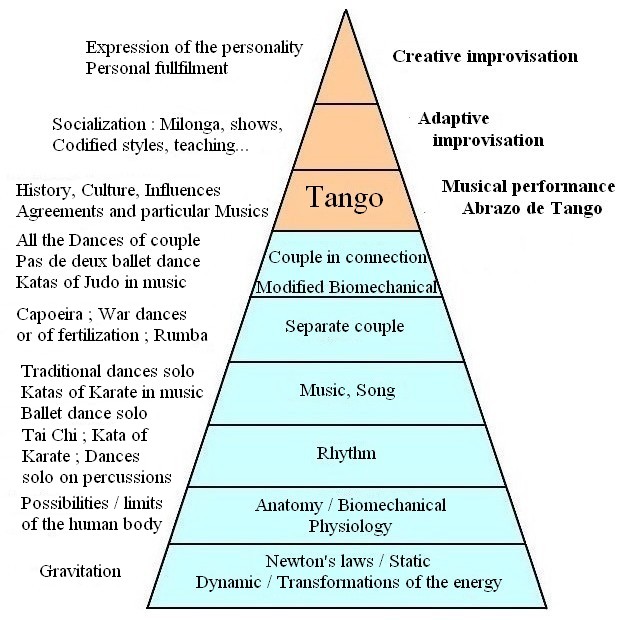
A few explanations
Gravitation : no movement can escape the laws of gravitation. Dancing a technique correctly means respecting all the laws of Statics and Dynamics, as well as the various transformations of Energy. Teaching requires the knowledge and understanding of these laws in the first place. If not we would only teach reproduction, we would limit the capacities of adaptation and invention; moreover, the teacher would deprive himself of a powerful tool of analysis of techniques.
The Possibilities of the Human Body : if the dancer never transcends them, the teacher might put in check, or endanger his pupils if his knowledge in this field is insufficient. Mastering biomechanics is fundamental in teaching: it commands respect for the laws of nature - mechanics, anatomy and physiology. It allows to make the most of the possibilities and limits of the human body, safely.
Rhythm : it is essential to put movement in kinetics; it gives the elements which will prevail in the transformations of energy. Rhythm variations are also the first possibilities of Adaptation and Interpretation. Eventually they will participate, often in a dominating way, in the artistic dimension of execution.
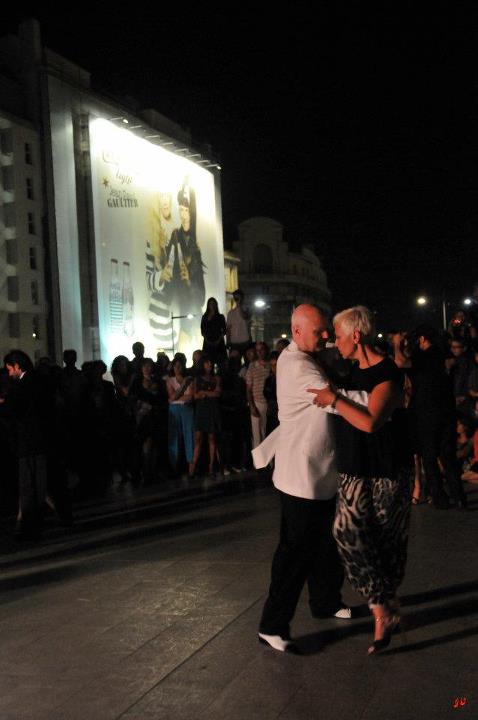 Music :
it is going to overlap with the rhythm, or to contain it and transform it, but above all, it will enable to choose between various interpretations according to the chosen melodic line while putting in accord the feelings expressed by the composer and those of the dancer. Its polyphonic and polyrhythmic forms will offer multiple choices of interpretation to the dancers.
Music :
it is going to overlap with the rhythm, or to contain it and transform it, but above all, it will enable to choose between various interpretations according to the chosen melodic line while putting in accord the feelings expressed by the composer and those of the dancer. Its polyphonic and polyrhythmic forms will offer multiple choices of interpretation to the dancers.
Application in the couple : free, without physical link. The notion of synchronization can be set up. At first through rhythm, then through the melodic line, finally by the look. Through rhythm: each dancer synchronizes with it, both dancers will thus be together. Then the melodic line: each dancer will synchronize his choreographic line with it, so they will be synchronized together. Finally by the look: to refine this synchronization and manage their relationships in space. Essentially non material communication.
The couple in mechanical connection/close contact : the first element refers to biomechanics, each mobile body undergoing the mechanical influences of the other one; it is no longer a question of two separate mobiles. Then communication is going to be altered by the notion of driving force and leading. The kinaesthetic aspect will then take a dominating place. As regards dances, the “Abrazo” is not Tango-specific
History, Culture, Convention : it is what differentiates one dance from the others, what makes it original, and gives it a common language recognized by the followers..
Socialization : it is the application in a place of sociability, where other codes and constraints appear.
Expressing oneself : when dancing expresses the dancer’s personality and feelings straightforwardly.
The various phases of modification of the established plans : reference definitions used in the approach
► Interpretation: it is the first phase that the apprentice dancer will meet. Without modifying any sketch in space, he will be able to vary rhythms, intensities, expressions according to his feeling. Admittedly, this is not Tango-specific, it exists in all the dances, with the slight difference that some dances use repetitive and undeformable rhythmic cells which allow less flexibility (ex: the three times of Waltz, six times of Rock, Clave of Salsa)..
► Adaptive improvisation: the dancer will cut out or modify introductions or ends of techniques in order to be able to chain them and adapt to the changing space of the ball. Interpretation can help to adapt (managing speed for instance). Possibilities can be found in numerous dances, in a more obvious way in dances of circulation (ex: Paso Doble).
► Creative improvisation: it is the moment when the body of the dancer answers directly the requests of the feeling (environment, music, partner, state of mind, etc.) to create something new, completely overstepping learnt or established plans, but still respecting the other aspects of the dance. To draw a parallel with one of the definitions used in music, it is creating a spontaneous, imaginary or "ex nihilo" movement using one’s creativity at the very instant, one’s technical experiences, and sometimes also fate. The notion of "unconscious movement "can also be associated to it.
These three processes can be set in action, whatever the dancer’s level. It can be observed however, that creativity arrives mostly when technical problems are mastered, which makes improvisation as defined above rather rare. If we draw a parallel with painting, a child's drawing is often very creative, but so that this creativity can be accepted in a culture, a well defined historical and sociological context, it will be necessary to comply with technique, provided it doesn’t kill the creative aspect: this is the difficult part!
« The most perfect technique is the one that we do not notice »
Pablo Casals
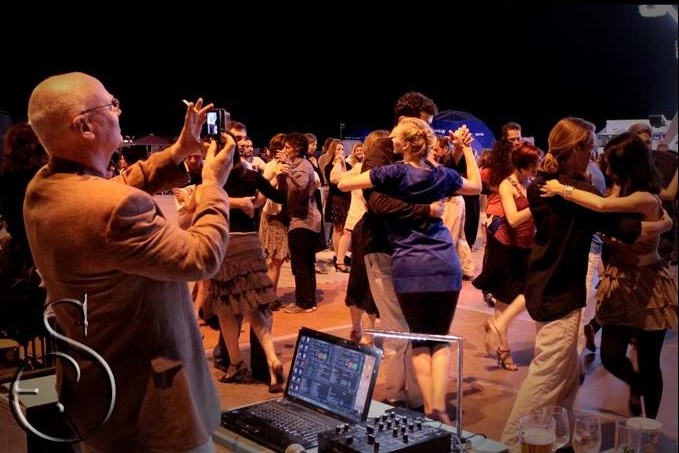
Remark about history
One can wonder how a popular dance, which was partially built over time by simple dancers or by professors who did not necessarily have the required knowledge to establish complex processes, managed to reach such a level of perfection
In fact, as time goes past, Argentine Tango has absorbed the basic techniques of multiple dances, Waltz, Polka, Mazurka, Danzon, Maxixe, One Step, Fox Trot, ballet dance, and now Salsa and Contemporary Dance, adding its own creations. While applying a kind of Darwinism of the movement, the dancers have only kept what was viable because they respected all the major aspects previously mentioned.
This capacity of absorbing different fully tried and tested techniques associated with appropriate creations, all this filtered by the dancers and by time, makes the universalism of the tango in terms of movements, and its durability.
But this is also what requires the utmost rigor in the teacher’s educational method; he has to take into account all this process of elaboration which has lasted for over 140 years...
As for the rest, emotion, feeling, artistic performance, the best is not to speak about it, but to live it… but it is quite another story. The classes are also made for that...
